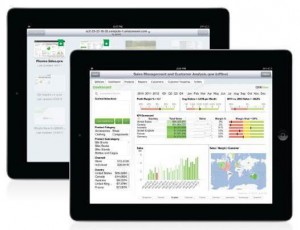
There is no doubt that demand for mobile BI (Business Intelligence) has been on the rise, with the ever-growing number of smartphones and tablets, and the adoption of “BYOD” (Bring Your Own Device) policies. However, formal adoption of mobile BI strategy seems to lag behind that demand. To understand why, let’s look at some common concerns that tend to create anxiety with mobile BI, and some suggestions as to how these could be addressed:
1. Security:
Without question, security is the most important concern for mobile BI, as the majority of enterprise apprehension revolves around well-publicized data security breaches. Accordingly, a comprehensive data strategy should be developed.
The most effective security strategy would be one that ensures that mobile BI users are connected, authenticated and authorized to access enterprise data through secured and dedicated BI servers. Nowadays, more and more BI technologies are pushing towards a 100% web-based model that ensures that no data is stored on the individual mobile device. Ensuring data security at all these levels is imperative:
- Application: Any BI application and its supporting mobile platform should adhere to and integrate with the existing security protocols to support authorization and authentication.
- Device: Password protection mechanism along with an automatic lock-out system in case of inactivity.
- Centralized Management: Maintain a central authentication system for password management.
- Encryption: Encryption of highly sensitive data flowing from servers to individual mobile devices is critical.
2. Data Governance:
Data Governance is an essential factor for mobile BI implementations. Introduction of mobile BI means more and more different types of users consuming more and more data. It also means greater variety of applications being consumed on a larger number of devices.
To ensure validity, scalability, and manageability of these applications, it is essential to manage a centralized reporting/dashboarding environment. This means that there needs to be a central source of control, perhaps a dedicated BI team that is responsible for implementing and maintaining a BI application environment ensuring trustworthy data sources. Additionally, steps should be taken to eliminate the need to recreate content or to repackage mobile data in order to significantly improve the overall manageability of a BI environment.
3. Design Considerations:
Increased roll-out of mobile BI demands stringent application distribution and design principles. Following are the common considerations:
- Type of Device: Tablet vs. Smartphone. Device type decisions will dictate considerations such as:
Screen resolution for application development: It is essential to come to an agreement to use a standard screen resolution enterprise-wide to develop and render the BI content. If that is a challenge due to diversity in hardware and software, the most commonly used screen resolution should be used as the standard resolution. If that is still an issue, then the BI applications should have the logic embedded to sense the resolution and adjust the application size dynamically.
Complexity of development: Complexity and content of the BI apps should be restricted to the business requirements. The apps should only focus on the subject matter and answering the right business questions, rather than attempting to display more information than needed, resulting in a cluttered situation. There is only so much real estate available, so mobile BI content should be very specific.
Device browser capabilities and limitations also dictate the interactive and navigation features that can be included in the applications. Every operating system or browser has its own set of limitations. These should be considered while developing mobile BI applications.
- Type of application: If the application is a dashboard with more interactive charts to illustrate KPIs that would be an ideal candidate for mobile BI. On the contrary, if it is a basic report, then it could be targeted for desktops.
- User Interface: The application user interface should create an environment that promotes intuitive navigation, interactivity, collaboration and information sharing to the end user.
About WIT
WIT is an analytics and automation consulting firm with over 25 years of experience. We help our clients build solutions to maximize the value of their data and analytics assets, and automate key business processes. In partnership with elite software companies, WIT’s capabilities span a broad spectrum of business functions and industry verticals. Learn more at www.witinc.com
